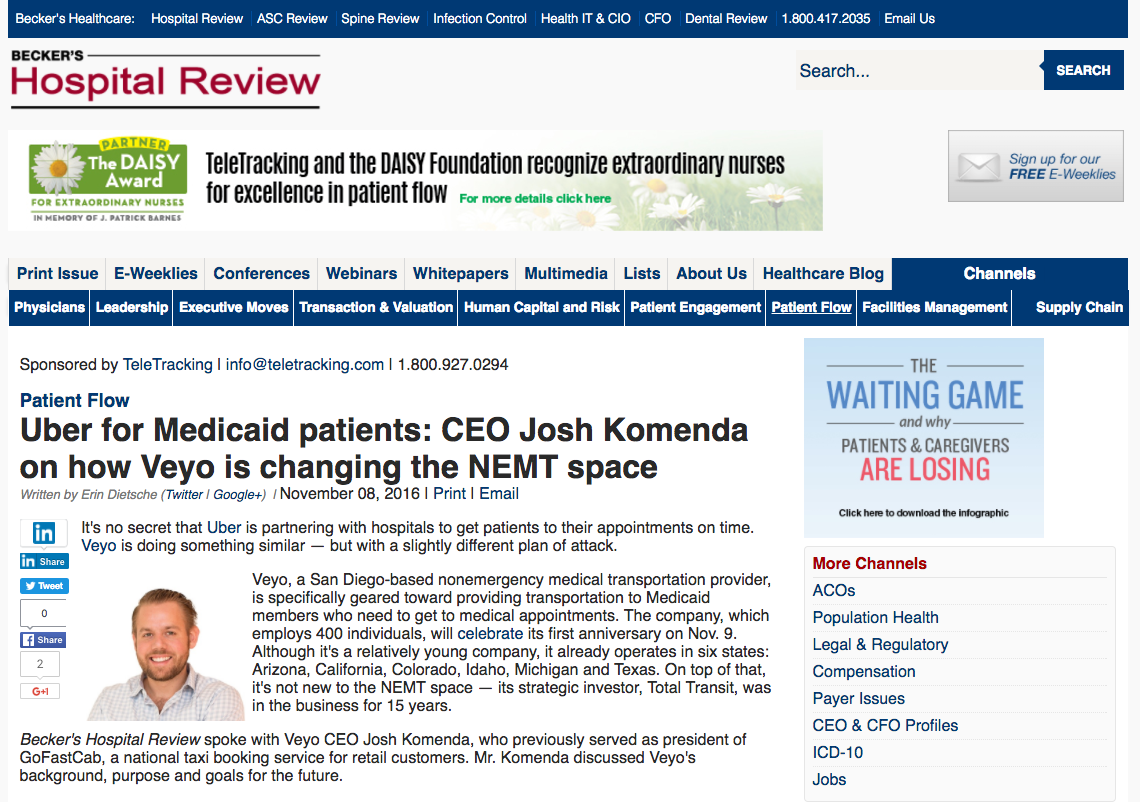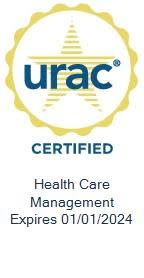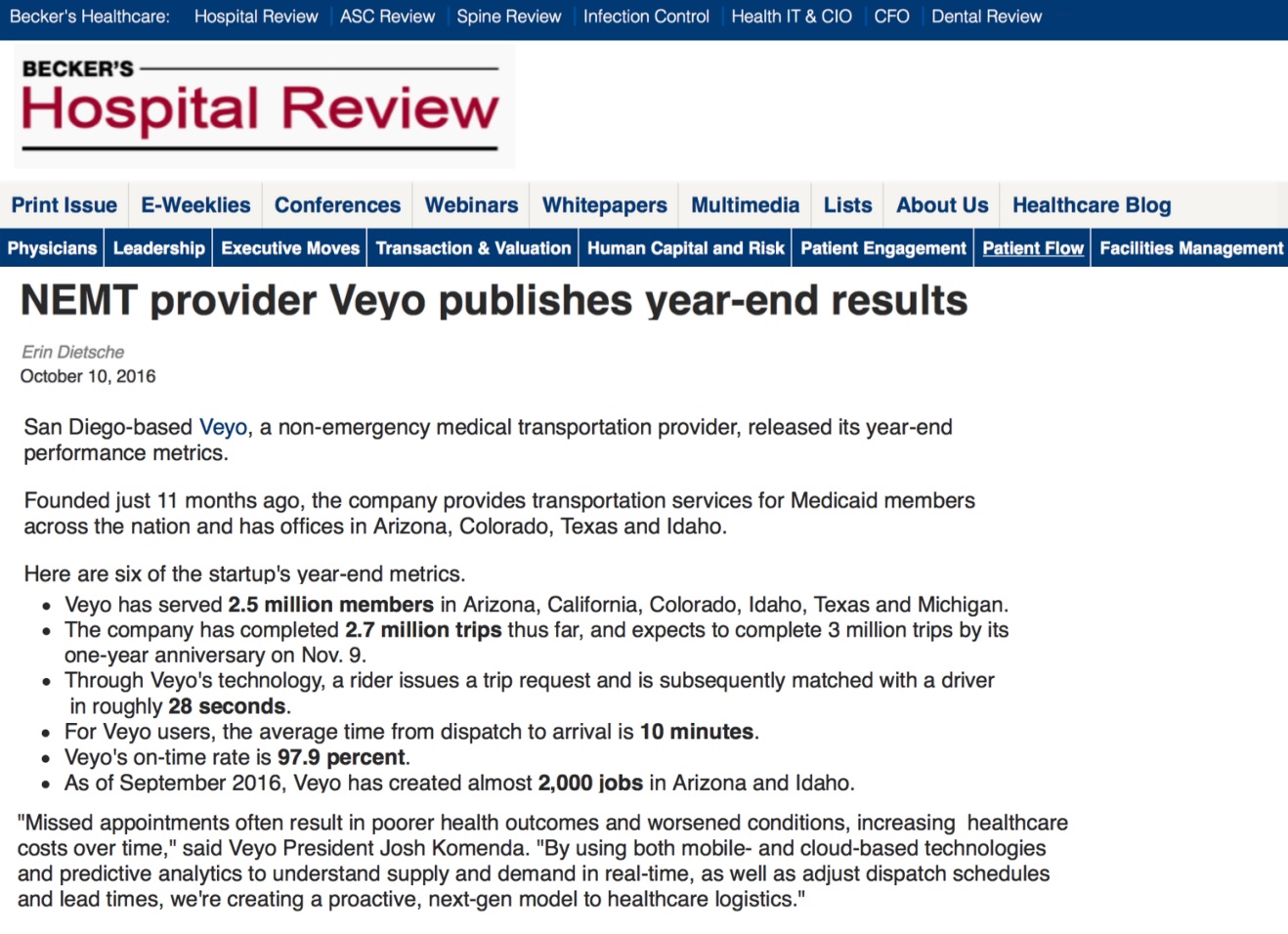Uber for Medicaid patients: CEO Josh Komenda on how Veyo is changing the NEMT benefit
November 8, 2016
It’s no secret that Uber is partnering with hospitals to get patients to their appointments on time. Veyo is doing something similar for the NEMT benefit — but with a slightly different plan of attack.
Veyo, a San Diego-based nonemergency medical transportation provider, is specifically geared toward providing transportation to Medicaid members who need to get to medical appointments. The company, which employs 400 individuals, will celebrate its first anniversary on Nov. 9. Although it’s a relatively young company, it already operates in six states: Arizona, California, Colorado, Idaho, Michigan and Texas. On top of that, it’s not new to the NEMT space — its strategic investor, Total Transit, was in the business for 15 years.
Becker’s Hospital Review spoke with Veyo CEO Josh Komenda, who previously served as president of GoFastCab, a national taxi booking service for retail customers. Mr. Komenda discussed Veyo’s background, purpose and goals for the future.
Note: Responses have been lightly edited for length and clarity.
Question: How was Veyo founded?
Josh Komenda: Veyo was founded because we saw a major need in the NEMT space. Broadly, it includes nonemergency medical transportation, but a large chunk of that is Medicaid-eligible patients. The $5 billion industry is a lifeline to Medicaid recipients so they can get to dialysis, stay compliant to their treatment plans and avoid the most expensive way to treat patients: the ambulance.
Even though it’s a noble idea, NEMT benefits haven’t been delivered well over the past 20 to 30 years. As we explored this more and more, we saw a poor level of service was rampant in the industry, as was people not using the benefit properly. Over the past five years, we noticed companies on the consumer side of transportation setting the standard of economic transparency suited to retail passengers. We wondered, “Can we take those things and bring them to Medicaid passengers?”
We’re now the first in the country to bring the ridesharing model specifically to the NEMT space. We conduct over 10,000 trips per day and have done over 2 million total trips.
Q: Where does the name “Veyo” come from?
JK: We went through a naming process last summer. We all started to coalesce around “Veyo,” which is a play on the word “conveyance.”
When we saw the name with the logo beside it, we felt it clicked with our company. We think of ourselves as a data-oriented company, and it logo and name invoke imagery of math and science.
Q: What’s the process of using Veyo like for patients, providers and drivers?
JK: We have an extremely streamlined, transparent system that takes over 15,000 requests per day. Veyo matches patients seamlessly to a massive track of drivers and uses predictive analytics to make sure everything is happening on time. Overall, we want to take the level of service people expect on the consumer side and bring it to healthcare.
The Medicaid population has a broad, diverse array of needs. You have people who are able-bodied all the way to people who are in wheelchairs or bariatric wheelchairs. In addition, there are different types of geographies depending on where patients live. Patients are traditionally used to using a call center, which we still make available. But they can now use mobile phone apps or a web portal when requesting service. We also do a will call option through which a person can make a phone call, send a text or push a button on the app when they’re ready to be picked up. In addition, we develop portals and tools for families of patients.
Our customers are primarily large insurance plans or state agencies that have multimillion budgets to deliver a transportation benefit.
We have different types of drivers. Our traditional commercial providers are wheelchair companies, and our independent driver model is our healthcare version of the Uber or Lyft model. We oversee our drivers directly — we recruit them, train them and make sure they’re fully qualified and background checked.
Q: Where does Veyo hope to be five years down the road?
JK: When we first started on this journey, the ability to change the Medicaid spend was our first goal. For a long time, the Medicaid world saw NEMT spending as a necessary cost. We knew if we could deliver the NEMT benefit with the same reliability as on the consumer side, it could help reduce healthcare costs.
Now we’re asking questions like, “Can we use the Veyo model to keep more people mobile longer?” or “Can we use our efficient logistics platform to put together prescription delivery services, improve people’s lives and cut healthcare costs even more?”
Written by Erin Dietsche (Twitter | Google+) | November 08, 2016



